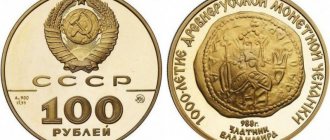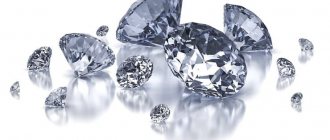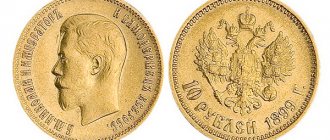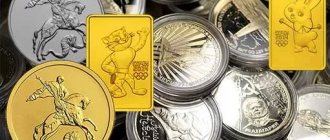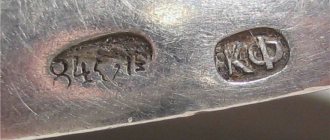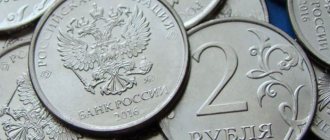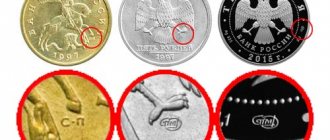The reference weights have changed recently. Before this, people used other units. Moreover, for each type of thing there were its own measurements. Numismatists, for example, often come across the following phrases: “4 spools and 55 shares” or “2 spools and 99 shares” when it comes to banknotes from the times of the Russian Empire. And today we use the proverb “small spool, but expensive.” Therefore, you should know that the spool is a measure of weight that is equivalent to 4.266 grams, or 1/96th of a pound.
This unit was used in relation to the weight of a gold coin. That's where the name came from. Moreover, spools appeared even earlier, in Kievan Rus. The coin was unremarkable in appearance, except that it consisted of 96 shares, and not one hundred, as is customary now.
Weight measure - spool
But this situation can be explained by the weight of the pound, as well as the six-digit counting system in those days. It is believed that the first example of a spool was a coin issued during the reign of Vladimir the Great in Rus'. It weighed about four grams. Therefore, citizens never had the question: how much is one spool? There are only ten such copies left, and all of them are in museums.
Old Russian units of measurement
In the pre-revolutionary system of units of measurement of mass, the basis was the Russian pound, which appeared in the 12th-14th centuries, initially equal to two hryvnias of silver. It differs from the pounds that existed in other countries, and by the end of the 19th century it was officially equivalent to 409.5124 grams, although the word "gram" was hardly used and was used only in international calculations. Large quantities of metal, food, or other goods were calculated in poods; one pood was equal to exactly 40 pounds, that is, 16.3804964 kg. 1 pound included 96 spools, which were equal to 96 shares. Most likely, the spool originally denoted the weight of a Byzantine (and then Russian) gold coin, which is mentioned in ancient documents. From the middle of the 18th century, a lot appeared, equated to three spools; this unit came from Europe, where it was used to measure the sample of an alloy in the lot system. The fraction (0.044435 g) was the minimum unit of mass measurement, approximately equal to the weight of a grain of one of the wild varieties of wheat - spelt. Ripe grains have almost perfectly equal mass, so it was convenient to weigh coins with their help. Grains were weighed not only in Rus', but also in many other countries, for example, the well-known carat, which was divided into grains - barley grains.
Weight designation on a 19th century silver coin
The ratio 1/96 was also used to determine the sample of a precious metal: 96 is pure metal without impurities, 48 is billon, that is, half sample. For example, sample 72 is equal to international 750 (measured in ppm). In some countries, fineness is measured in carats, with 24 carats being pure gold, 12 equaling 500 fine gold, etc. The largest measure of weight in Rus' was the berkovets - 10 poods, but it was not used to determine the mass of coins or metals for them. In 1918 V.I. Lenin signed the decree “On the introduction of the international metric system of weights and measures”; from that time on, the official use of old Russian weight norms ceased, but for several years they could be found in various documents of a local nature. The peasant population adapted to the new system for many decades. Now the term “pud” is used only in relation to 16-kilogram weights, and with significant rounding; other units are not used at all. Thus, the ratio of Old Russian units of weight measurement can be represented as: 1 pood = 40 pounds = 16380.496 g; 1 pound = 32 lots = 96 spools = 9216 shares = 409.5124 g; 1 lot = 3 spools = 288 shares = 12.79728 g; 1 spool = 96 shares = 4.26576 g; 1 share = 0.044435 g.
Weight unit conversions
In addition to this unit, there were other names applicable to larger weights of things. The system consisted of the following units:
- Puda. The pud as a Russian measure of weight was the largest indicator. It was 40 pounds. Of course, there were more than a pound of Berkovites, but they were not used in everyday life.
- Pound. In turn, one pound corresponded to 32 lots or was transferred immediately and amounted to 96 spools.
- Lotta. One lot was equal to three spools.
Such translations were easy to understand even for ordinary people in Rus'. Therefore, they were used quite often, and references to units of measurement are found in the sources of that time. Now the information is found in numismatic catalogs. And with the help of proportion, you can now easily find out how much the spool weighs.
Modern units of measurement for precious stones and metals
Weight of pure gold in grams
The carat, already described above, which is of Arabic origin, is now widely used to measure the weight of precious stones. The weight of one carat has changed at different times and in different countries, but is now equivalent to 0.2 grams. For metals, the English system of measures is used, which includes the English pound (453.59237 g), English ounce (28.349523125 g), grain (1/7000 of a pound), troy ounce (31.1034768 g), and other, lesser-known measures. The troy ounce (480 grains) has become an international measure of the weight of precious metals. The name comes from the city of Troyes in northern France, which in the Middle Ages was one of the important European trading hubs; the troy ounce is based on the French livre. Almost all investment and collection coins of Russia and other countries have a pure metal weight of a certain fraction of a troy ounce, or several ounces. Taking into account the fineness, the total weight of the coins is higher. For example, silver 3-ruble coins issued since 1992 include 1 ounce of pure silver, and the gold investment coin “St. George the Victorious” contains ¼ ounce of gold. The exchange rate of precious metals against foreign currencies is also expressed in troy ounces. Soviet gold chervonets, based on the Old Russian system of measures, differ slightly in weight from ¼ ounce, but are close to it. Photos provided by site users: Andrey_P, Moneta100, Admin.
Article last modified: 01/11/2018
Other articles
Zolotnik: what is it?
The weight of one spool is 4.265 grams.
During the times of Kievan Rus, a gold coin weighing 4.265 grams (96 shares) was called a zolotnik. The spool was used to indicate the purity of gold. For example, a gold coin weighing one spool contained impurities from the mass of a gold-containing alloy (21 shares) and gold (75 shares). In this case, the coin was considered to be made of 75-carat gold—in other words, “75-spool gold.” The spool mass measure was also used to measure the amount of pure silver in coins.
Comments:
Hello!
My great-grandmother said that her father: “Measured gold in buckets.” This phrase is passed down from generation to generation. I have been looking for information for a long, long time, WHAT buckets are we talking about? (how rich was our family before the revolution?) This apparently happened in the 19th century - my great-grandmother was born at the end of the 19th century. Help me please. THANK YOU. 05/16/2012 at 17:24:10
Most likely, your great-grandmother wanted to show with this phrase that her father was very rich. It’s just a saying, like: “Money doesn’t matter to chickens.” In fact, gold was not measured with any buckets.
Author: Admin 05/17/2012 at 02:30:31
To add a comment, register
The history of the appearance of a weight measure called a spool
Today, scientists cannot say for sure where the very name of such a measure of weight as a spool came from. Presumably this name comes from the times of Kievan Rus. It is known that during the time of Prince Vladimir the Great (10th century), one of the small princely gold coins was called “zlatnik”.
Probably, later this coin began to be actively used as a weight when weighing products made of precious metals. And gradually, from the name of the coin, the “spool” got its name - a measure of weight used to determine the mass of a product made of precious metal.
The first written mention of a spool as a measure of weight dates back to the 13th century. In one of his business documents, Prince Mstislav from Smolensk uses the word “zolotnik” not as the name of a coin, but as a measure of weight. It was probably during that period that the proportion of pure precious metal in a particular coin or other product made of gold and silver was measured with the help of spools.
Over time, the popularity of the spool as a measure of weight spread. And since 1711, the spool received the status of an official measure of weight not only for gold and silver, but also for other precious metals and was used until 1927.
There is also an alternative opinion that the word "spool" comes from the name of the metal gold. However, this is unlikely, since a spool was also used to measure the weight of platinum and silver.
This weight measure contributed to the emergence of the so-called spool sampling system, which was widespread in the Russian Empire.
Information about other coins with denominations:
1. 24 Shares (Refining Ingot) 2. 3 Zolotnik (Refining Ingot) 3. 10 Zolotnik (Refining Ingot) 4. Refining Ingot (trial) 5. Payment Ingot.
1/8 pound 6. Commendation coin March 1, 1702 7. Commendation coin February 1, 1702 8. Commendation coin January 10, 1702 9. Commendation coin February 9, 1703 show more... If you notice any inaccuracies, write about it here: “Book comments and suggestions."
To add a photo of a coin to the catalog, send it by e-mail. The condition of the coin does not matter, but it is important that the photo is clear and taken by you personally, and not copied from the Internet. You are not required to have the coin; the photograph can be taken in a museum or anywhere else with the permission of the owner. Please photograph the coin from both sides, and, if possible, the edge. The photo will be posted by the administrator shortly. If you notice a low-quality photo, you can send a replacement. In the letter, we ask you to indicate exactly how authorship should be indicated (your nickname, real name, or not at all). The authorship remains with you, but the photograph can be used within this site for the design of articles, catalogs or directories. Each photo receives our site’s logo, which protects it from distribution beyond the boundaries of this project (but does not guarantee this). If you do not want to place the logo, please let us know. Questions regarding the value or definition of coins will be ignored! Only photos for filling the site are accepted to the specified e-mail.
The proverb “Small is the spool, but dear” - origin
Russian speech is unique, because it contains Slavic wisdom, the roots of which go far into the past. And, despite the fact that we have unfairly forgotten some of the words or have been replaced by foreign words and new concepts, we carry the energy and wisdom of generations in proverbs. How often do you hear or say the proverb “Small is small, but expensive”? What meaning do you attach to this phrase? We suggest you sort this out with the best philologists of the Russian language.
So, this proverb uses four words, one of which is not currently used. And, therefore, young people may understand it incorrectly. Therefore, let’s take a look at S.I.’s explanatory dictionary. Ozhegov, the meaning of the word spool. As indicated in the dictionary, this is a measure of weight that was used during the Russian Empire. Its specific gravity is 1/96 of a pound, also equivalent to 4.26 modern grams.
The spool is small, but dear - the roots of the proverb go back centuries
This unit of weight was actively used for weighing precious metals and stones by jewelers, as well as for determining the weight of valuable seasonings, etc. That is, the spool referred to the specific gravity of expensive things.
Over time, the Russian people gave subsequent generations a proverb that read: “Small is the spool, but dear.”
Varieties
Varieties of the coin 1 Zolotnik (Refining ingot) differ in the types of stamps used during minting. The type of variety indicates by which side of the coin it can be identified. The degree of rarity has a parameter from 1 to 5 and applies only to a given coin, regardless of how rare it is itself: 1 - common, 2 - infrequent, 3 - rare, 4 - very rare, 5 - extremely rare. The market price of a higher grade variety is always approximately 3-10 times higher, for example grade 2 will be approximately 3-10 times more expensive than grade 1, and grade 3 will be 10-50 times more expensive than grade 1. Cost is a relative concept, since the demand for them is often lower than the number of offers.
No. 1 Type: A
